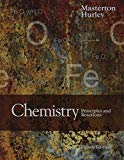
Concept explainers
Write an equation for the reaction of chloroacetic acid
Interpretation:
The equation for the reaction between chloroacetic acid and trimethylamine, the equilibrium constant and concentration at equilibrium for the reaction should be determined.
Concept introduction:
The relationship between the concentration of products and reactants at equilibrium for a general reaction:
Where A, B, C, and D represents chemical species and a, b, c, and d are the coefficients for balanced reaction.
The equilibrium expression, Kc for reversible reaction is determined by multiplying the concentrations of products together and divided by the concentrations of the reactants. Each concentration is raised to the power that is equal to the coefficient in the balanced reaction. So, the expression is:
Square brackets represent the concentration.
Answer to Problem 60QAP
The reaction between chloroacetic acid and trimethylamine is:
The concentration is
Explanation of Solution
The reaction between chloroacetic acid and trimethylamine is neutralization reaction.
The neutralization reaction between chloroacetic acid and trimethylamine is:
In order to determine the value of equilibrium constant of the reaction, the dissociation of chloroacetic acid and trimethylamine in accordance to Arrhenius view may be written as:
Since,
So,
As on reversing the reaction, the value of constant of reversed reaction is the invert value of K.
When the reaction is expressed as the sum of two or more reactions the value of equilibrium constant, K for the final reaction is determined by the product of the equilibrium constant of individual reactions.
Adding equation (1), (2), and (3):
Thus, K =
The concentration at equilibrium is determined by constructing the ICE table for the reaction:
The equilibrium constant for the above reaction is:
Substituting the values:
On solving the quadratic equation:
Thus, the concentration is
The reaction between chloroacetic acid and trimethylamine is:
The concentration is
Want to see more full solutions like this?
Chapter 22 Solutions
Bundle: Chemistry: Principles and Reactions, 8th, Loose-Leaf + OWLv2, 1 term (6 months) Printed Access Card
- Draw the friedel-crafts acylation mechanism of m-Xylenearrow_forwardDon't used hand raiting and don't used Ai solutionarrow_forward1. Base on this experimental results, how do you know that the product which you are turning in is methyl 3-nitrobenzoate(meta substituted product ) rather than either of the other two products? 2. What observation suggests that at least a small amount of one or both of the other two isomers are in the mother liquor?arrow_forward
- Explain Huckel's rule.arrow_forwardhere is my question can u help me please!arrow_forwardSo I need help with understanding how to solve these types of problems. I'm very confused on how to do them and what it is exactly, bonds and so forth that I'm drawing. Can you please help me with this and thank you very much!arrow_forward
- Steps and explanation.arrow_forwardProvide steps and explanation please.arrow_forwardDraw a structural formula for the major product of the acid-base reaction shown. H 0 N + HCI (1 mole) CH3 N' (1 mole) CH3 You do not have to consider stereochemistry. ● • Do not include counter-ions, e.g., Na+, I, in your answer. . In those cases in which there are two reactants, draw only the product from 989 CH3 344 ? [Farrow_forward
 Chemistry: Principles and ReactionsChemistryISBN:9781305079373Author:William L. Masterton, Cecile N. HurleyPublisher:Cengage Learning
Chemistry: Principles and ReactionsChemistryISBN:9781305079373Author:William L. Masterton, Cecile N. HurleyPublisher:Cengage Learning Introductory Chemistry: A FoundationChemistryISBN:9781337399425Author:Steven S. Zumdahl, Donald J. DeCostePublisher:Cengage Learning
Introductory Chemistry: A FoundationChemistryISBN:9781337399425Author:Steven S. Zumdahl, Donald J. DeCostePublisher:Cengage Learning Organic ChemistryChemistryISBN:9781305580350Author:William H. Brown, Brent L. Iverson, Eric Anslyn, Christopher S. FootePublisher:Cengage Learning
Organic ChemistryChemistryISBN:9781305580350Author:William H. Brown, Brent L. Iverson, Eric Anslyn, Christopher S. FootePublisher:Cengage Learning- Chemistry: Matter and ChangeChemistryISBN:9780078746376Author:Dinah Zike, Laurel Dingrando, Nicholas Hainen, Cheryl WistromPublisher:Glencoe/McGraw-Hill School Pub Co
 Chemistry & Chemical ReactivityChemistryISBN:9781337399074Author:John C. Kotz, Paul M. Treichel, John Townsend, David TreichelPublisher:Cengage Learning
Chemistry & Chemical ReactivityChemistryISBN:9781337399074Author:John C. Kotz, Paul M. Treichel, John Townsend, David TreichelPublisher:Cengage Learning Chemistry & Chemical ReactivityChemistryISBN:9781133949640Author:John C. Kotz, Paul M. Treichel, John Townsend, David TreichelPublisher:Cengage Learning
Chemistry & Chemical ReactivityChemistryISBN:9781133949640Author:John C. Kotz, Paul M. Treichel, John Townsend, David TreichelPublisher:Cengage Learning





